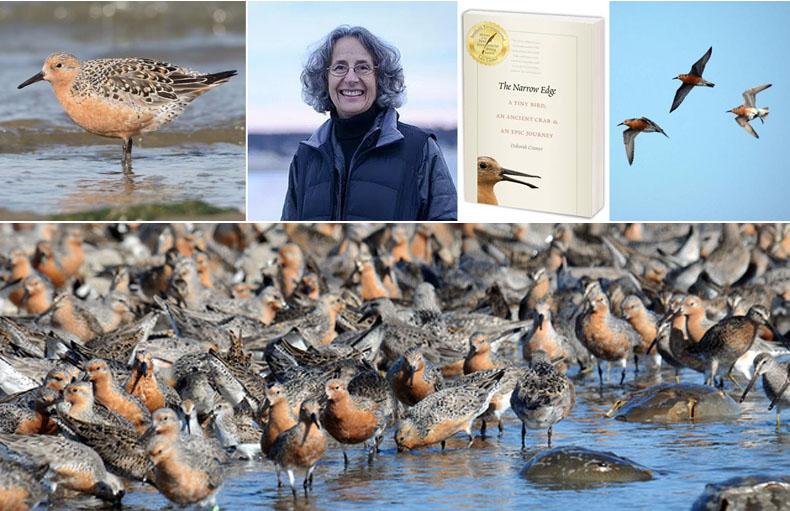|
Book Review: The Narrow Edge: A Tiny Bird, An Ancient Crab & An Epic Journey
Reviewd by Tamsin Venn
The Red Knot (Calidris canutus rufa), a little red sandpiper, is one of the longest distance bird migrators, flying 9,300 miles from the tip of South America in Tierra del Fuego to the tundra in the central Canadian Arctic.
It stops at feeding areas along the Atlantic Flyway, for up to two weeks, to replenish fat stores depleted by the long flight. Knots can complete non-stop flights of 1,500 miles or more. Long and slender wings of this small robin-sized shorebird make it adapted to go great distances.
According to bird banding data, large flocks start from Tierra del Fuego in March, with other recorded stops in the Caribbean, Florida, Georgia, South Carolina, Virginia, Delaware Bay (the 7,500-mile mark), New York, and Massachusetts (Monomoy Islands and Wellfleet Wildlife Sanctuary). Closer to their destination, they stop in the Mingan Islands in the Gulf of St. Lawrence and James Bay and arrive in the High Arctic in the early summer.
All of this is beautifully chronicled by nature writer Deborah Cramer in her book
The Narrow Edge: A Tiny Bird, An Ancient Crab & An Epic Journey (Yale University Press, New Haven, Ct. and London; 2015; 293 pages). The book has won several awards, including The Rachel Carson Book Award.
We got acquainted with Cramer when she parked her car at our house to kayak through the marshes at low tide and scope out horseshoe crabs, whose eggs the knots are dependent on for a high-fat meal along their journey.
The Red Knot's most important refueling spot, along with thousands of other shorebirds (it is commonly observed in the company of Semipalmated Sandpipers, Ruddy Turnstones, and Sanderlings) is Delaware Bay. Here it times its arrival with spawning horseshoe crabs, which come ashore on the rising tides of May's new and full moons. Red Knots gorge on easily-digestible pinhead-sized horseshoe crab eggs, providing a fast and energy-rich food.
The knots switch their diet to the abundant insect life when they reach the Arctic, but there is no respite from their struggles. In a good year, less than 60 percent of the eggs will hatch, and many chicks are eaten before they fly by Arctic foxes, Herring Gulls, and Parasitic Jaegers. If a nest fails in the short Arctic summer, there's often no time to try again.
In breeding grounds, "For shorebirds this far north, long light filled days, abundant insects, fewer parasites, and less predation offset the substantial metabolic and energetic costs of getting here. Just over an increase of just 29 degrees of latitude between James Bay and northern Ellesmere Island, the rate of nest predations drops 65 percent," writes Cramer, explain why it's worth the birds' efforts to fly all the way to the High Arctic.
Both parents watch the nest, but soon after the eggs hatch, the mothers depart the High Arctic for their journey south in mid-July, adult males in early to mid-August, followed in late August by the young who remarkably find their way to wintering grounds on their own.
Like many birds, Red Knots are able to adapt to a wide range of temperatures and climatic conditions. They survive in the 80-mph-plus hurricane-strength winds on Tierra del Fuego and the delayed springs in the Arctic when the tundra is still covered in snow.
In true dedication to research for her book, Cramer visited key areas in the knots' migration path from Tierra del Fuego to the Arctic. She expounds on how their flyway faces many perils. Those include but are not limited to oil spills in Argentina, beach degradation in Delaware Bay, plummet of horseshoe crab populations due to their use as bait and in medical testing, beach habitat destruction on Cape May and Jersey Shore from Hurricane Sandy, rising acid in seawater affecting growth of mussels, global warming and the greening of the Arctic tundra, hunting of shorebirds in French Guiana, Guyana, and Suriname.
Despite these depressing facts, she does manage to provide some upbeat research including new flyway refueling stations under way. On Staten Island, for instance, New York City is replacing the Fresh Kills Landfill, one of the world's largest garbage dumps, with a park. Salt marsh is coming back, seagulls have departed, and soon the knots may return.
This is a fascinating, in-depth study of a shorebird that travels the entire Atlantic coast, and a special sight for those of us lucky to encounter it on our kayak travels.
|



